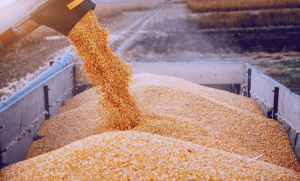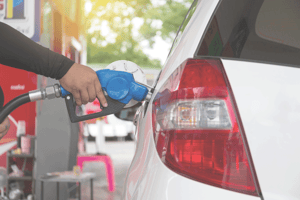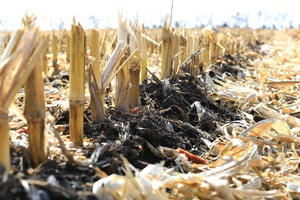
Ethanol 101
What is Ethanol?
![]() Ethanol is a simple alcohol. It’s the result of fermentation of plant sugars and occurs naturally in the environment. It’s the same alcohol in spirits, wine and beer. When microorganisms in nature — or at a distillery — break down simple carbohydrates in fruits and grains, as well as more complex starches in stalks, branches or leaves, they convert those sugars into ethanol. In its concentrated, purified form, ethanol burns clean and efficiently powers engines.
Ethanol is a simple alcohol. It’s the result of fermentation of plant sugars and occurs naturally in the environment. It’s the same alcohol in spirits, wine and beer. When microorganisms in nature — or at a distillery — break down simple carbohydrates in fruits and grains, as well as more complex starches in stalks, branches or leaves, they convert those sugars into ethanol. In its concentrated, purified form, ethanol burns clean and efficiently powers engines.
Nearly every gallon of gasoline sold in the U.S. contains some ethanol. Henry Ford’s Model T. was built to use it, and Mercedes-Benz, whose motto is The Best or Nothing, has called ethanol “the best kept performance secret in the world.”
Where Does Ethanol Come From?
Corn products made for human consumption, like corn flour, corn meal, or sweet corn, use only 10% of the overall harvest. About 35% goes to livestock feed, 34% is for ethanol, and the rest is either exported or stored as surplus.
Ethanol is produced in a facility known as a biorefinery. There, corn is processed to ferment starch in the kernels. This produces alcohol and leaves a considerable amount of fiber and protein, which is returned to the food chain in the form of livestock feed referred to as dried distillers grains or DDGs (in this way, field corn used for both ethanol and food).
Fermentation in a biorefinery is very similar to what happens in a distillery, winery, or brewery — with some important distinctions. At most ethanol plants, every effort is made to reduce energy inputs and carbon intensity. Modern technologies allow ethanol producers to convert sugars to alcohol without “cooking” the grain, which is usually how it works at breweries.
The ethanol is distilled, or purified, and then denatured to make it undrinkable. It is typically transported by rail to fuel terminals where it is blended with gasoline.
Over the years, farmers and biorefineries have made significant strides improving the efficiency of corn and ethanol production without expanding the acreage to grow corn.
Can I Put Ethanol in My Car?
Yes, almost certainly. All gasoline-powered passenger cars and light-duty trucks enjoy outstanding performance with E10, which is less expensive than straight gas and better for the environment. You’ve probably been fueling with E10, which is 10% ethanol and 90% gas, without even thinking about it. It accounts for nearly all motor fuel in the U.S. because virtually every vehicle is approved to use E10.E15, or 15% ethanol, is even better for all cars, light duty trucks, and SUVs built since model year 2001 — some 98% of the American automotive fleet. Most are actually warrantied by their manufacturers to run on E15, which delivers an “88” octane rating. At the pump, you’ll often see it labeled “Unleaded 88” or “Regular 88” for that reason. It’s often denoted by a blue label or blue dispenser hose.
Higher blends of ethanol, the most common being E85, are not as prevalent outside of California or the Midwest, but you might find some stations that offer E20, E30, and even E50. These mid-to-high-level blends should only be used in flexible fuel vehicles (FFVs), which can burn any ethanol blend you put in your tank. Flex fuel vehicles give you maximum options at the pump.

Why Use Ethanol as Fuel?
Ethanol is a superior alternative to gasoline. It’s a renewable fuel that burns cleaner than gas. With an octane rating of 115, it improves fuel quality and power output when blended with sub-octane gasoline. It’s also considerably less expensive than gas.
Henry Ford’s Model T. was built to use it, and Mercedes-Benz, whose motto is “The Best or Nothing,” has called ethanol “the best kept performance secret in the world.” In the world of auto racing, E85, a fuel blend featuring 85% ethanol, has been a preferred product in numerous circuits. NASCAR uses E15 and the Formula 1 series uses E10. Ethanol’s high octane allows for greater compression and expansion ratios in engines — with power and efficiency benefits well known and widely published, according to Motor Trend Magazine.
Recently, Dodge announced that its final version of its legendary Challenger muscle car would be designed to make 1025 horsepower when burning E85.
Ethanol not only delivers performance in vehicles, it delivers security to Americans. That’s because ethanol is a renewable domestic product. It displaces the need for 15 billion gallons of gasoline every year. It saves families money at the pump. And it contributes to the economic vitality of thousands of rural communities across the country.

What Does Not Run On Ethanol?
Virtually everything will operate great on E10, but don’t put E15 or E85 in older cars (model year 2000 or earlier), motorcycles, snowmobiles, ATVs, side-by-sides, boats, vehicles with heavy-duty engines (busses, delivery trucks, etc.) or small motors like chainsaws, lawnmowers, weeders or similar. E15 and E85 are NOT approved for those engines — so technically it’s against the law to fuel with them.The issue is not the quality of the ethanol blend, but the design and quality of the engine. Those machines are either built to perform on straight gasoline or tend to sit unused for long periods (lawnmowers, boats, chainsaws). Over time, condensation may form in the tank of an idle engine and cause problems. Unfortunately, you will need to pay a little more at the pump for straight gasoline to operate that equipment. Please enjoy the environmental and pocketbook benefits of ethanol with your family car instead.

Is Ethanol Better for the Environment?
![]()
It is much better than gasoline, and in some cases better than other low carbon fuels.
Ethanol is already part of the environment. It occurs in nature — all around you, every day. As a normal product of plant fermentation, ethanol biodegrades quickly. Most of the carbon dioxide produced by corn farming and biorefining is absorbed from the atmosphere by the following year’s corn crop. Recent improvements on the farm have led to stronger corn crops that pull more carbon dioxide out of the atmosphere and transfer it into the soil — a natural kind of carbon sequestration, but on a massive scale across millions of acres of land.
In your car, ethanol delivers performance at lower cost with far fewer emissions than gasoline. Recent studies demonstrate that today’s ethanol is about 50% cleaner in greenhouse gas (GHG) emissions compared to gasoline. ACE is constantly collaborating with respected research scientists to properly analyze ethanol’s GHG emissions and to ensure that improvements on the farm are accounted for in the carbon scoring.
Although many detractors have published studies or fabricated claims that ethanol is no better or even worse than gasoline, the most thorough science proves that this simple fuel burns cleaner right now — and is getting cleaner every year.
Conservation Farming
Ethanol's exceptional environmental performance is largely due to shifts in agriculture that don’t always make headlines: precision ag technology, no-till farming, and improved seed genetics. These are all strategies that reduce inputs like energy and fertilizer while simultaneously increasing corn yields on a given acre of land. Today’s corn famers reap three to four times as many bushels per acre as their grandparents did.
Progress on the farm has led to the pursuit of two tantalizing environmental goals: zero- or net-negative-carbon corn by 2050. In other words: corn and ethanol production that is at least carbon neutral — and at best captures more carbon than it releases. These targets are in reach. And ACE is actively helping its members achieve them.
The environment is already benefitting from ethanol. Each year on the road to net-negative carbon corn, it gets better and better.

Sustainable Aviation Fuel
Sustainable aviation fuel (SAF) is a renewable alternative to conventional jet fuel that could be used in today’s aircraft and immediately improve the environmental impacts of flight.
SAF made from renewable biomass and waste resources can deliver the performance of petroleum-based jet fuel with a fraction of its carbon footprint – without requiring any technological changes to the aircraft.

![]()
